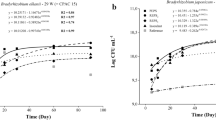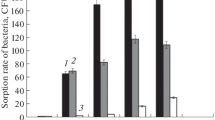Abstract
The influence of lipopolysaccharides (LPS), glucans, and their unseparated complexes on nodulation activity of rhizobia and efficiency of their symbioses with pea plants was studied in vegetation tests. Two Rhizobium leguminosarum bv. viciae strains which differed in their symbiotic properties were used: strain 31 (fix+, efficient, moderately virulent, and moderately competitive) and strain 248b (fix–, inefficient, highly virulent, and highly competitive). Preparations of LPS–glucan complex and the respective LPS from the highly virulent strain 248b increased the nodulation activity of both strains by 10–26%. Analogous preparations from a less virulent strain 31 did not have this ability. Unseparated LPS–glucan complexes from these strains increased the productivity of plants infected with the efficient strain by 18–23% but did not change it in plants inoculated with the other, inefficient strain. No significant influence of LPS preparations on the symbiosis productivity was observed. Glucans from both strains enhanced the nodulation ability of the highly virulent strain by 36–56%. In addition, treatment of pea plants with glucan from strain 248b increased nitrogen fixation by root nodules by 27% in plants inoculated with strain 31. In general, the formation and efficiency of the symbiosis of R. leguminosarum bv. viciae with pea plants was more influenced by preparations from strain 248b, highly virulent but deficient in nitrogen fixation, than by preparations from the nitrogen fixation–proficient but less virulent strain 31.
Similar content being viewed by others
REFERENCES
Orgambide, G.G., Lee, J., Hollingsworth, R.I., and Dazzo, F.B., Structurally Diverse Chitolipooligosaccharide Nod Factors Accumulate Primarily in Membranes of Wild Type Rhizobium leguminosarum Biovar trifolii, Biochemistry, 1995, vol. 3, pp. 3832–3840.
Denarie, J. and Cullimore, J., Lipo-Oligosaccharide Nodulation Factors: a Minireview of a New Class of Signaling Molecules Mediating Recognition and Morphogenesis, Cell, 1993, vol. 74, pp. 951–954.
Carlson, R.W., Bhat, U.R., and Reuhs, B., Rhizobium Lipopolysaccharides; Their Structures and Evidence for Their Importance in the Nitrogen-Fixing Symbiotic Infection of Their Host, Plant Biotechnology and Development, Gresshoff, P.M., Ed., Boca Raton: CRC, 1992, pp. 33–44.
Breedveld, M.W. and Miller, K.J., Cyclic β-Glucans of the Family Rhizobiaceae, Microbiol. Rev., 1994, vol. 58,no. 2, pp. 145–161.
Kosenko, L.V., Glucans of Rhizobiaceae, Mikrobiol. Zh., 1996, vol. 58,no. 6, pp. 71–80.
Zdorovenko, G.M., Extracellular Lipopolysaccharide of Gram-Negative Bacteria, Mikrobiol. Zh., 1989, vol. 50,no. 4, pp. 98–108.
Carlson, R.W., Kalembasa, S., Turowski, D., Pachori, P., and Noel, K.D., Characterization of the Lipopolysaccharide from a Rhizobium phaseoli Mutant That Is Defective in Infection Thread Development, J. Bacteriol., 1987, vol. 169,no. 11, pp. 4923–4928.
Higashi, S. and Abe, M., Promotion of Infection Thread Formation by Substances from Rhizobium, Appl. Environ. Microbiol., 1980, vol. 39, pp. 297–301.
Dazzo, F.B., Truchet, G.L., Hollingsworth, R.I., Hrabak, E.M., Pankratz, H.S., Philip-Hollingsworth, S., Salzwedel, J.L., Chapman, K., Appenzeller, K., Squartini, A., Gerhold, D., and Orgambide, G., Rhizobium Lipopolysaccharide Modulates Infection Thread Development in White Root Hairs, J. Bacteriol., 1991, vol. 173,no. 17, pp. 5371–5384.
Kots', S.Ya., Mikhalkiv, L.M., Mandrovs'ka, N.M., Kosenko, L.V., and Zatovs'ka, T.V., Vpliv glyukanu Sinorhizobium meliloti na utvorennya ta funktsionuvannya azotfiksuval'nikh simbiotichnikh sistem lyutserni za riznim vodozabezpechennyam, Fiziol. Biokhim. Kul't. Rast., 2002, vol. 34,no. 5, pp. 413–418 (in Ukranian).
Kosenko, L.V., Mikhalkiv, L.M., Krugova, E.D., Mandrovskaya, N.M., Zatovskaya, T.V., and Kots', S.Ya., Biological Activity of Glucan, Mikrobiologiya, 2003, vol. 72,no. 5, pp. 633–638.
Patseva, M.A. and Kosenko, L.V., Biological Activity of Rhizobium leguminosarum Exopolysaccharides in the Nodulation Process, Mikrobiologiya, 1991, vol. 60,no. 2, pp. 273–278.
Kosenko, L.V., Antipchuk, A.F., and Rangelova, V.N., Effect of Rhizobium leguminosarum bv. viciae Exopolysaccharides on the Formation and Efficiency of the Symbiosis of Pea Plants with Homologous Root Nodule Bacteria, Mikrobiologiya, 1995, vol. 64,no. 2, pp. 205–210.
Kosenko, L.V., Khailova, G.F., and Korelov, V.E., Effect of Rhizobium leguminosarum bv. viciae Exopolysaccharides on the Nodulation and Rizogenesis of Pea Plants, Fiziol. Biokhim. Kul't. Rast., 2001, vol. 33,no. 4, pp. 347–350.
Westphal, O. and Jann, K., Bacterial Lipopolysaccharides. Extraction with Phenol-Water and Further Applications of the Procedure, Methods Carbohydr. Chem, 1965, vol. 5, pp. 83–91.
Hardy, R.W., Holsten, R.D., Jackson, E.K., and Burns, R.S., The Acetylene-Ethylene Assay for N2 Fixation: Laboratory and Field Evaluation, Plant Physiol., 1968, vol. 43, pp. 1185–1207.
Arinushkina, E.V., Rukovodstvo po khimicheskomu analizu pochv (A Manual of Chemical Analysis of Soils), Mosk. Gos. Univ., 1961, pp. 151–153.
Dospekhov, B.A., Metodika polevogo opyta s osnovami statisticheskoi obrabotki rezul'tatov issledovanii) [The Methodology of Field Experiments (with the Basic Principles of Statistical Processing of Experimental Data)], Moscow: Agropromizdat, 1985.
Kosenko, L.V., Rangelova, V.N., and Antipchuk, A.F., Polysaccharides of Rhizobium leguminosarum and Their Interaction with Lectin of the Host Plant, Mikrobiol. Zh., 1989, vol. 51,no. 5, pp. 71–77.
Borthakur, D., Barbur, C.E., Lamb, J.W., Deniels, M.J., and Downie, J.A., A Mutation That Blocks Exopolysaccharide Synthesis Prevents Nodulation of Peas by Rhizobium leguminosarum but Not of Beans by R. phaseoli and Is Corrected by Cloned DNA from Rhizobium or the phytopathogen Xanthomonas, Mol. Gen. Genet., 1986, vol. 203, pp. 320–323.
Author information
Authors and Affiliations
Rights and permissions
About this article
Cite this article
Antipchuk, A.F., Kosenko, L.V. The Influence of Lipopolysaccharides and Glucans from Two Rhizobium leguminosarum bv. viciae Strains on the Formation and Efficiency of Their Symbioses with Pea Plants. Microbiology 73, 51–55 (2004). https://doi.org/10.1023/B:MICI.0000016368.23462.eb
Issue Date:
DOI: https://doi.org/10.1023/B:MICI.0000016368.23462.eb




